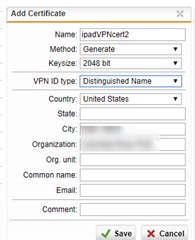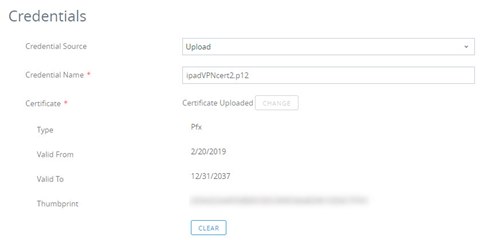Hi folks, I need help getting some cisco clients connected to my UTM. Specifically these are iPads with a cisco IPsec profile on them. Basically, I'm really bad with certificates. I do not understand why this isn't working. I'll throw in some screenshots too.
Here's what I did:
1. Generate new cert in the UTM, all default settings with just my country, city, and org in it. 2048 bit keysize, VPN ID: Distinguished name.
2. Create a new local user in the UTM.
3. Set this user's authentication cert as the one I just generated.
4. Head into remote access -> cisco VPN client. Set it to my wan interface, server certificate is the local x509 cert (default). Selected my desired LAN devices, and put that new user into the users and groups. AUTO firewall rules ON.
5. Download that generated cert from the utm.
5. Create new profile for iPad in my MDM, tell it to connect to my wan IP. set the username.
6. Upload the cert to the ipad, tell it to use that for authentication.
So, to summarize: there are two certificates in play here. One, the serverside cert, which is the default x509. The other, which is a cert I manually generated, is pushed to the ipad.
when I attempt to connect with the iPad, it fails to connect with the error: "Could not validate the server certificate"
and here is the livelog:
|
2019:02:25-15:06:16 utm-2 pluto[8684]: packet from 174.224.20.149:8419: received Vendor ID payload [RFC 3947]
2019:02:25-15:06:16 utm-2 pluto[8684]: packet from 174.224.20.149:8419: ignoring Vendor ID payload [4df37928e9fc4fd1b3262170d515c662] 2019:02:25-15:06:16 utm-2 pluto[8684]: packet from 174.224.20.149:8419: ignoring Vendor ID payload [8f8d83826d246b6fc7a8a6a428c11de8] 2019:02:25-15:06:16 utm-2 pluto[8684]: packet from 174.224.20.149:8419: ignoring Vendor ID payload [439b59f8ba676c4c7737ae22eab8f582] 2019:02:25-15:06:16 utm-2 pluto[8684]: packet from 174.224.20.149:8419: ignoring Vendor ID payload [4d1e0e136deafa34c4f3ea9f02ec7285] 2019:02:25-15:06:16 utm-2 pluto[8684]: packet from 174.224.20.149:8419: ignoring Vendor ID payload [80d0bb3def54565ee84645d4c85ce3ee] 2019:02:25-15:06:16 utm-2 pluto[8684]: packet from 174.224.20.149:8419: ignoring Vendor ID payload [9909b64eed937c6573de52ace952fa6b] 2019:02:25-15:06:16 utm-2 pluto[8684]: packet from 174.224.20.149:8419: ignoring Vendor ID payload [draft-ietf-ipsec-nat-t-ike-03] 2019:02:25-15:06:16 utm-2 pluto[8684]: packet from 174.224.20.149:8419: ignoring Vendor ID payload [draft-ietf-ipsec-nat-t-ike-02] 2019:02:25-15:06:16 utm-2 pluto[8684]: packet from 174.224.20.149:8419: ignoring Vendor ID payload [draft-ietf-ipsec-nat-t-ike-02_n] 2019:02:25-15:06:16 utm-2 pluto[8684]: packet from 174.224.20.149:8419: received Vendor ID payload [XAUTH] 2019:02:25-15:06:16 utm-2 pluto[8684]: packet from 174.224.20.149:8419: ignoring Vendor ID payload [Cisco-Unity] 2019:02:25-15:06:16 utm-2 pluto[8684]: packet from 174.224.20.149:8419: ignoring Vendor ID payload [FRAGMENTATION 80000000] 2019:02:25-15:06:16 utm-2 pluto[8684]: packet from 174.224.20.149:8419: received Vendor ID payload [Dead Peer Detection] 2019:02:25-15:06:16 utm-2 pluto[8684]: "D_for ipad to daniel-lt-3"[10] 174.224.20.149:8419 #371: responding to Main Mode from unknown peer 174.224.20.149:8419 2019:02:25-15:06:16 utm-2 pluto[8684]: "D_for ipad to daniel-lt-3"[10] 174.224.20.149:8419 #371: NAT-Traversal: Result using RFC 3947: peer is NATed 2019:02:25-15:06:16 utm-2 pluto[8684]: | NAT-T: new mapping 174.224.20.149:8419/8439) 2019:02:25-15:06:16 utm-2 pluto[8684]: "D_for ipad to daniel-lt-3"[10] 174.224.20.149:8439 #371: ignoring informational payload, type IPSEC_INITIAL_CONTACT 2019:02:25-15:06:16 utm-2 pluto[8684]: "D_for ipad to daniel-lt-3"[10] 174.224.20.149:8439 #371: Peer ID is ID_DER_ASN1_DN: 'C=us, L=omitted, O=omitted, CN=ipad' 2019:02:25-15:06:16 utm-2 pluto[8684]: "D_for ipad to daniel-lt-3"[10] 174.224.20.149:8439 #371: crl not found 2019:02:25-15:06:16 utm-2 pluto[8684]: "D_for ipad to daniel-lt-3"[10] 174.224.20.149:8439 #371: certificate status unknown 2019:02:25-15:06:16 utm-2 pluto[8684]: "D_for ipad to daniel-lt-3"[5] 174.224.20.149:8439 #371: deleting connection "D_for ipad to daniel-lt-3"[10] instance with peer 174.224.20.149 {isakmp=#0/ipsec=#0} 2019:02:25-15:06:16 utm-2 pluto[8684]: "D_for ipad to daniel-lt-3"[5] 174.224.20.149:8439 #371: we have a cert and are sending it 2019:02:25-15:06:16 utm-2 pluto[8684]: "D_for ipad to daniel-lt-3"[5] 174.224.20.149:8439 #371: Dead Peer Detection (RFC 3706) enabled 2019:02:25-15:06:16 utm-2 pluto[8684]: "D_for ipad to daniel-lt-3"[5] 174.224.20.149:8439 #371: sent MR3, ISAKMP SA established 2019:02:25-15:06:16 utm-2 pluto[8684]: "D_for ipad to daniel-lt-3"[5] 174.224.20.149:8439 #371: sending XAUTH request 2019:02:25-15:06:16 utm-2 pluto[8684]: packet from 174.224.20.149:8439: Informational Exchange is for an unknown (expired?) SA 2019:02:25-15:06:26 utm-2 pluto[8684]: ERROR: asynchronous network error report on eth2 for message to 174.224.20.149 port 8439, complainant 174.224.20.149: Connection refused [errno 111, origin ICMP type 3 code 3 (not authenticated)] 2019:02:25-15:07:26 utm-2 pluto[8684]: "D_for ipad to daniel-lt-3"[5] 174.224.20.149:8439 #371: max number of retransmissions (2) reached STATE_XAUTH_R1 2019:02:25-15:07:26 utm-2 pluto[8684]: "D_for ipad to daniel-lt-3"[5] 174.224.20.149:8439: deleting connection "D_for ipad to daniel-lt-3"[5] instance with peer 174.224.20.149 {isakmp=#0/ipsec=#0} |
Why do you think it isn't working? Thank you!
This thread was automatically locked due to age.







